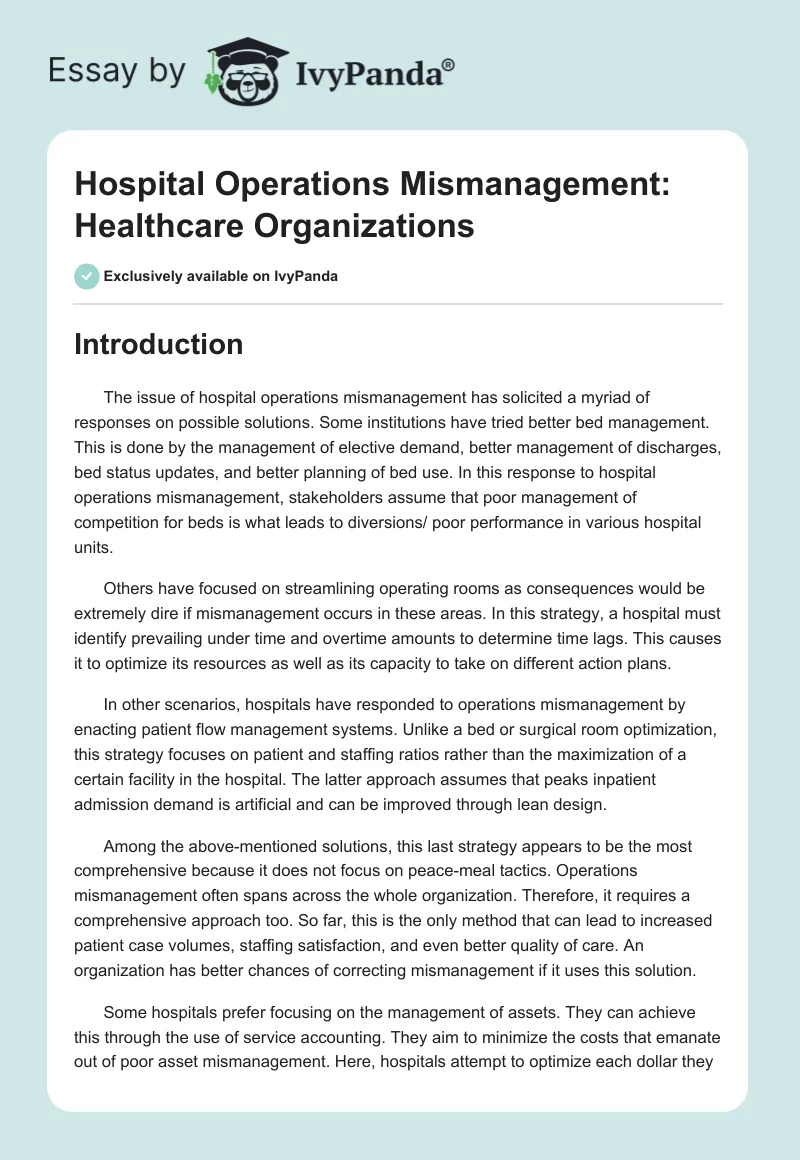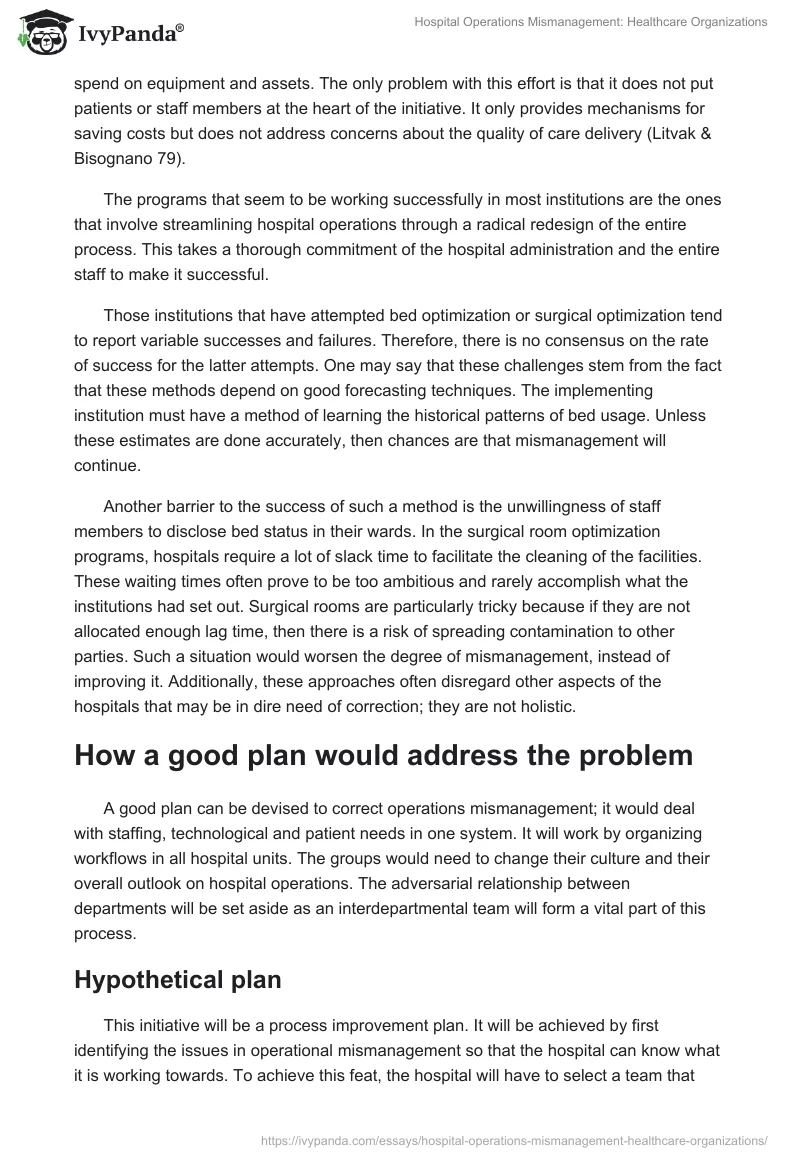Introduction
The issue of hospital operations mismanagement has solicited a myriad of responses on possible solutions. Some institutions have tried better bed management. This is done by the management of elective demand, better management of discharges, bed status updates, and better planning of bed use. In this response to hospital operations mismanagement, stakeholders assume that poor management of competition for beds is what leads to diversions/ poor performance in various hospital units.
Others have focused on streamlining operating rooms as consequences would be extremely dire if mismanagement occurs in these areas. In this strategy, a hospital must identify prevailing under time and overtime amounts to determine time lags. This causes it to optimize its resources as well as its capacity to take on different action plans.
In other scenarios, hospitals have responded to operations mismanagement by enacting patient flow management systems. Unlike a bed or surgical room optimization, this strategy focuses on patient and staffing ratios rather than the maximization of a certain facility in the hospital. The latter approach assumes that peaks inpatient admission demand is artificial and can be improved through lean design.
Among the above-mentioned solutions, this last strategy appears to be the most comprehensive because it does not focus on peace-meal tactics. Operations mismanagement often spans across the whole organization. Therefore, it requires a comprehensive approach too. So far, this is the only method that can lead to increased patient case volumes, staffing satisfaction, and even better quality of care. An organization has better chances of correcting mismanagement if it uses this solution.
Some hospitals prefer focusing on the management of assets. They can achieve this through the use of service accounting. They aim to minimize the costs that emanate out of poor asset mismanagement. Here, hospitals attempt to optimize each dollar they spend on equipment and assets. The only problem with this effort is that it does not put patients or staff members at the heart of the initiative. It only provides mechanisms for saving costs but does not address concerns about the quality of care delivery (Litvak & Bisognano 79).
The programs that seem to be working successfully in most institutions are the ones that involve streamlining hospital operations through a radical redesign of the entire process. This takes a thorough commitment of the hospital administration and the entire staff to make it successful.
Those institutions that have attempted bed optimization or surgical optimization tend to report variable successes and failures. Therefore, there is no consensus on the rate of success for the latter attempts. One may say that these challenges stem from the fact that these methods depend on good forecasting techniques. The implementing institution must have a method of learning the historical patterns of bed usage. Unless these estimates are done accurately, then chances are that mismanagement will continue.
Another barrier to the success of such a method is the unwillingness of staff members to disclose bed status in their wards. In the surgical room optimization programs, hospitals require a lot of slack time to facilitate the cleaning of the facilities. These waiting times often prove to be too ambitious and rarely accomplish what the institutions had set out. Surgical rooms are particularly tricky because if they are not allocated enough lag time, then there is a risk of spreading contamination to other parties. Such a situation would worsen the degree of mismanagement, instead of improving it. Additionally, these approaches often disregard other aspects of the hospitals that may be in dire need of correction; they are not holistic.
How a good plan would address the problem
A good plan can be devised to correct operations mismanagement; it would deal with staffing, technological and patient needs in one system. It will work by organizing workflows in all hospital units. The groups would need to change their culture and their overall outlook on hospital operations. The adversarial relationship between departments will be set aside as an interdepartmental team will form a vital part of this process.
Hypothetical plan
This initiative will be a process improvement plan. It will be achieved by first identifying the issues in operational mismanagement so that the hospital can know what it is working towards. To achieve this feat, the hospital will have to select a team that would establish what is wrong with the hospital operations and then curves out the desired outcome to deal with the problem. Members of this team need to cut across all the segments of the institution to foster a spirit of inclusion. After identifying the problems, the team will then draw a diagram of the operations in the hospital and the waste that occurs or the areas that require improvement. Since different institutions may have different needs, then one must customize solutions to those problems. However, the following action plans will still form a critical part of the process improvement in the concerned hospital.
Synchronization of documentation efforts will be an important part of this plan. The hospital will aim at creating a central database of the medical history of its patients. This will entail procedures carried out within the institution and previous ones. Some patients may be taking medications that could affect their health in the concerned hospital so this information must be noted.
The hospital will also have a tracking system that is designed to prompt staff members about patient results in various tests. If results from a specific laboratory are not returned at the right time, then a nurse or staff member will be reminded about this. Nurses will be advised to fill in patient charts only after ensuring that results were received and reviewed. Proper documentation is always the first step in ensuring that issues of negligence or oversight do not arise in any given hospital.
Physicians will be expected to have a thorough understanding of all the medical treatment that takes place before and after their turn. This will involve emergency care, surgeries for outpatients as well as inpatients, hospitalizations, and other consultations that need to be done. The reason why physicians are placed at the center of this process is that they are the primary care dispensers. Patients must start with them before they can report to other units. Therefore, these staff members must carry out their duties flawlessly.
The plan will have a provision for questioning certain orders, tests, and purchases that appear to be out of the ordinary by staff members. If they realize that calculations are done wrongly concerning certain payments or purchases, they can state this and thus correct those errors. Improper use of equipment must also be identified by members of a particular department. Furthermore, the selected team will be responsible for ascertaining that these misuses are terminated. Special emphasis should be given to sensitive equipment as this may lead to the development of dire consequences on patients.
The hospital needs to create a system of dialogue with the concerned patients. They need to be told about the possibility of damage that can result from certain medical procedures. Stakeholders need to realize that certain processes have dire side effects over others. Therefore, they should accept treatment with these risks in mind. Cases of malpractice can be easily avoided once patients are incorporated into their care processes.
Perhaps the most important aspect of this process overhaul will be to manage the flow of patients. In this regard, the hospital will schedule admissions to ensure that patients come in at the right time. The latter applies to appointments and non–emergency care programs. It is imperative to deal with these peaks as they are the major cause of stress among staff members, patient dissatisfaction, and low quality of care (Brown 24). The team will sit down and work alongside other members of the organization to identify ways in which they can alter patient flows.
Conclusion
Such an approach will require an assessment of the hospital culture and procedures. The team must be honest enough to take on problems in the institution aggressively. It will also need to work hand in hand with the administration to make the plan work successfully.
Works Cited
Brown, Charles. “Winter planning: seasonal cycles.” Health services Journal 112(2002): 24-25. Print.
Litvak, Eugene & Margaret Bisognano. “More patients, less payment: increasing hospital efficiency in the aftermath of health reform.” Health Affairs 30.1(2005): 76-80. Print.


